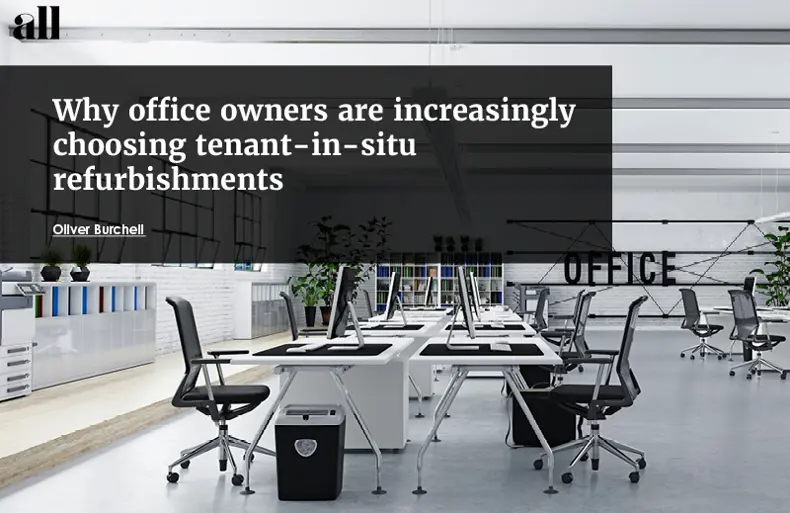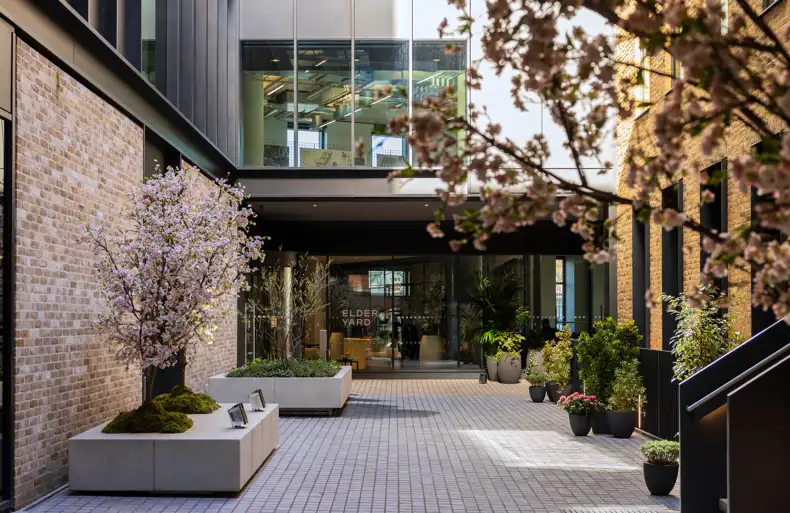Blog | Asset Management | Offices
Why office owners are increasingly choosing tenant-in-situ refurbishments

In an uber-competitive market for quality office space, landlords are faced with the dilemma of how to upgrade space to meet occupiers’ ever-changing demands. That’s why the Asset Management team at Allsop, is increasingly advising clients to work with tenants to deliver in-situ refurbishments and why landlords should prioritise working with existing tenants to provide new Cat B space. This not only reduces the risk to the landlord by minimising void periods but is also likely to lead to longer lease terms as the tenant would have been able to help design the space. This strategy provides the tenant with high-quality, purpose-built space and enables both parties to benefit from improved ESG credentials.
The way we work has changed dramatically in recent years, and office spaces need to evolve to keep up with modern requirements. Tenants are increasingly recognising the need for upgraded workspaces to entice employees, who often prefer working from the comfort of their homes, back to the office. While some big corporates have instructed their employees to return to the office full-time, many businesses are reluctant to take drastic measures and choose to invest in upgrading their spaces to make them more welcoming instead.
A disruption-free solution
Rather than relocate to a new space upon the expiry of tenancy, there is the option for companies to conduct tenant-in-situ refurbishments, whereby landlords undergo improvements to the space while the tenant remains in the building or seeks a viable short-term alternative. This practice is becoming more popular as businesses look to modernise their offices without disrupting established routines for workers. Often, businesses struggle with the time and knowledge to scout for new space, which takes them away from their day-to-day activities. For the tenant, it would be more suitable to place trust in advisors who understand and can address the cost and timescale associated with moving.
It would be no stretch to say the pandemic has transformed workplace culture, with employees becoming more selective about where, when and how they work. Today, businesses understand the need to provide better office environments to encourage employees back on-site in a world where working from home has become a convenient option. For landlords, this shift showcases an opportunity. Rather than dealing with vacancies or speculative refurbishments which may not align with tenant expectations, they can work directly with existing tenants to upgrade spaces in a way that meets their needs. It is our role as asset managers to understand the market and work with both landlords and tenants to ensure we are all on the same page.
Hitting two birds with one stone
For both the landlord and tenant, in-situ refurbishments can offer long-term financial advantages. What makes this option attractive for landlords is the fact that tenants who receive a high-quality refurbished space are more likely to commit to longer lease terms, ensuring steady income.
Tenants, on the other hand, can spread costs over a lease period rather than investing large sums upfront for a new fit-out, making financial planning more manageable.
Though in-situ refurbishments appear to make sense in the times we are in now, a successful one requires careful consideration. As alluded to earlier, we play a crucial role in strategically balancing tenant expectations with landlord budgets. While tenants may have grand visions for their office redesign, costs can quickly escalate. A well-managed process ensures that refurbishments remain financially viable while still delivering high-quality, customised spaces. Our hands-on approach to working closely with landlords and tenants alike helps both parties achieve their desired goals.
Most businesses are able to adopt flexible working arrangements nowadays and although they may need to temporarily relocate employees for a short period, most companies can handle such disruptions without significant operational issues. For landlords, the upfront cost of a Cat-B fit-out can be substantial and riskier given the works are not tailored to a specific tenant, which leads to the potential for wasted furniture and materials, undermining landlords’ environmental responsibility. However, the alternative – attempting to attract a new tenant with vacant space – presents its own risks, which is why refurbishments with tenants in-situ present such a compelling compromise.
This approach helps both landlords and tenants save money. For the landlord, void periods are much less of a concern, and if Cat-B space is provided by the landlord, the tenant’s initial outlay is significantly less. Tenant in-situ refurbishments reduce uncertainty whilst providing the tenant with high-quality, purpose-built space, enabling both parties to benefit from improved ESG credentials. There is a sizable percentage of buildings in London that will struggle to hit EPC B’s (which is an issue considering the UK government has proposed that all rented commercial properties must have at least an EPC rating of B by 2030), therefore having the ability to conduct rolling refurbishments is beneficial to both the landlord and tenant.
The demand for high-quality work environments isn’t going away. Employees now expect offices that offer collaborative spaces, wellness amenities and modern technology. Landlords have needed to adapt by offering spaces to meet these expectations. Tenant-in-situ refurbishments provide a pain-free way to achieve this, whilst offering a win-win solution for all parties involved.
Related Insights

Podcast: The Impact of Rates Multipliers on Rates Bills
Want to know more or would simply like some advice? We hope you find this podcast useful. If you want to know more about topi...

Commercial Investment National Office Market Update
Allsop sees this as an opportune moment to enter the market before further base rate reductions potentially drive-up competit...

Maximise the potential of your commercial investment with informed decisions
Conclusion Purchasing commercial property requires a comprehensive approach that includes thorough research, financial planni...

Discover Norton Folgate
A New Chapter Since 2019, British Land have undertaken meticulous restoration and redevelopment efforts to honour the past...